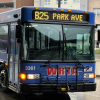Thomas E. Whall bought his house on High Street from his father when he was 24 years old. Now, 40 years later, he's known some of his neighbors on Dorchester's Meeting House Hill for decades and watched the neighborhood evolve into an area developers are eyeing.
“I was born in St. Margaret’s, which is right up the street," Whall bellowed with pride while standing on his doorstep. "I was born in this zip code. I spent my whole life here."
Across the street from Whall's house is a Greek Revival-style manse that once housed ministers of the historic First Parish Church. A leafy, three-quarter acre lot, the property recently sold for $1.7 million to a trio of developers who plan to build a four-story condo complex behind the manse.
The complex would feature 60 small units. Thirteen percent of them would be designated "affordable" as required by the city's inclusionary development policy (IDP). But those eight units are not enough to sway Whall and other longtime residents into supporting the proposal.
The tension points to one of the challenges of Boston's IDP. Even though the policy is intended to compel housing-builders to contribute to the city's supply of affordable units, it can sometimes fuel the kind of density that some longtime residents reject.
“I think it’s disgraceful in every possible way,” said Whall. "Sixty units is just ridiculous, with 30 parking spots and 500 square-foot units. So, no future, no families, no children, no pets, no nothing. It's transient."
The High Street project is still unofficial, as the three developers who make up 29 High Street Dot LLC — Brad Cangiamila, Jonathan Cournoyer and Fernando Dalfior — have yet to file a letter of intent with the Boston Planning and Development Agency. They have indicated they're receptive to making the project smaller in response to community criticism.
Dalfior declined to comment on specifics of the High Street project with WGBH News. Cangiamila and Cournoyer could not be reached for comment.
Some longtime residents of Meeting House Hill don’t like the loss of green space and the limited parking. But mostly they object to the size of the development.
"There's a big difference between 60 units and 10 units, or even 20 units — huge difference in terms of the kind of impact it would have on a neighborhood," said Jennifer Johnson, the vice president of the Meeting House Hill Civic Association, at a recent meeting.
Whall, Johnson and others on Meeting House Hill say they don't consider themselves "anti-development." They generally support increasing the city’s affordable housing stock, but not with such dense development on a residential street.
Boston City Councilor Frank Baker, who represents the area, said he has also encouraged the group to scale back their project to preserve the neighborhood feel along the street. That would mean fewer affordable units.
The Boston Planning and Development Agency and the Department of Neighborhood Development are conducting a review done every three years of the inclusionary development policy.
“There’s definitely an impact, and it's economic, and it potentially affects the viability of the project itself,” said Mark Kablack, a board member of the Homebuilders and Remodelers Association of Massachusetts.
Kablack and others in the industry say in order to satisfy the IDP, developers add more market-rate units to make a project financially viable — and that means greater density.
“So you’re building more market-rate units, and the profit from those market-rate units — because you’re building more than you normally would, you’re spreading the net profit across the project and subsidizing the cost of building the affordable units,” he explained.
Soon there could be even more incentive for density. City Councilor Lydia Edwards, who chairs the council's Housing and Community Development Committee, has called for the IDP requirement to go as high as 20 percent of units.
"I think it's a perfect example of how housing isn't about the market and just letting the market go," Edwards told WGBH News. "Government has a role to play when it comes to housing — it certainly played a very negative one for many years, with redlining and the way it segregated housing, so government not only has a role, but I think a moral obligation to get in there and get it right."
At least five councilors have expressed support for an increase. Besides Edwards, Councilors Ed Flynn, Kim Janey and Michelle Wu did so at a committee hearing earlier this month. In a statement to WGBH News, Councilor Anissa Essaibi George said she also supports upping the requirement.
When asked about residents who want to maintain the character of their neighborhoods, Edwards explained her belief that more people will get behind more projects with more affordable units.
“I have found that they’re more likely to support a project if it actually is affordable, or if it’s senior housing, or if it’s family housing, if it’s ownership options — things like that that continue to grow a neighborhood," she said.
Back at High Street, Whall said he does want to see development where families can grow.
"I’m a grandfather," he said. "It’s music to me when I hear the kids up the street playing in the school ground."





